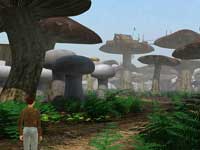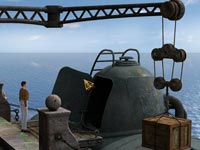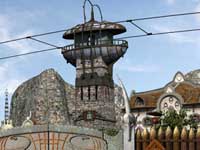Back in the early days of computer gaming, it was common for titles to take their leads from literary works: The Lord of the Rings, Fahrenheit 451, Hitchhiker's Guide to the Galaxy, Alice in Wonderland, Below the Root, Neuromancer and more all helped to inspire games, many of which linger in the memory even today. That's far less common in the modern gaming climate; the audience and its attitude are both very different, resulting in a generally less rich source of inspiration for many games. Of those, if even one stands out from the crowd, it's an achievement.
What would have been the fate of a game like Journey to the Center of the Earth had it been released 18 years ago or so? It's difficult to say. The game would have fit in with others of that era given its selection of source material: Jules Verne's 1864 novel of the same name. The book presents a challenge to create something truly distinctive while offering the possibility of inspiring a work at least as memorable as the classics from that era. What's most likely to have happened back then is what has happened in 2003: the creation of a better-than-mediocre game that manages to balance the weight of its heritage with modern expectations, while never delivering on all of its promise.
At least Viva Adventure has used Verne's novel as a springboard for their own ideas, rather than modifying the original work to suit their own requirements. The story of this Journey to the Center of the Earth picks up 140 years or so after Verne's left off, with Adriane, a photojournalist, accidentally discovering the world beneath the surface when stranded by a helicopter accident. During the course of her explorations, she befriends the humans and giants who co-exist there, and discovers that all is not well: a war might threaten the lives of those both above and below the surface. She must spend most of the game attempting to unravel the secret allegiances and goals of the world's inhabitants, and stop the war—if such a war truly exists—while finding a way to return to her own life above ground.
Journey to the Center of the Earth provides a strong balance between fulfilling the necessity of its plot and promoting the wonders and benefits of exploration itself. It accomplishes this primarily through its graphics, which are imbued with a strong sense of style and continuity that give the game exactly the feeling it needs. Many of the game's visuals have a Myst-like feeling to them (despite being rendered mostly in 3D, to quite good effect), but never do they detract from the game itself. The graphics adequately capture Adriane's emotions, critically establishing in the game's earlier sections the sense of awe she's experiencing. A forest of giant mushrooms, a bridge over a seemingly bottomless chasm, and, most importantly, the dinosaurs she encounter are executed in such a way as to provoke the appropriate feeling of wonder in the player.
That's no small feat—haven't movies and other computer games shown us all this already? Additionally, the city of Askiam, on which much of the game is centered, is cleverly rendered with heavy Victorian architectural influences (though, of course, filtered through a century of technological innovation), drawing a connection with Verne that would have been easy to overlook. When the game takes on something of a pulp feel in its later sections, the visuals change as well, recalling cheap sci-fi comic books or even a bit of the now-classic Henry Levin 1959 film version of Verne's novel. (Adriane even must watch a newsreel at one point that distorts propagandistic paranoia to extremes, yet never strays beyond the boundaries of appropriateness.) That these styles were so seamlessly brought together is a noteworthy achievement.
Yet I can't help but wish that same attention to detail had been paid the rest of the game. While much of Journey to the Center of the Earth feels like a labor of love, its final execution is frequently frustrating, even sloppy in the way it handles elements as basic as movement or interaction with the game world. Though these problems seem minor enough early on, they eventually mount to a degree sufficient enough that no nice visuals or voice acting (which is generally pretty good, if undistinguished) can make up for them.
Everything in the game is achieved with the use of icons, which have been employed in adventure games with varying degrees of success for almost fifteen years. There are no revolutions in the system here, though it's technically fine: if you want to move somewhere on the screen, you click there; if you move the mouse cursor over an item you can interact with, the cursor changes; if you want to access items in your inventory (including the computer that stores the documents, photos, and other information Adriane collects), you can right-click to show that icon bar, and then click again to hide it.
Unfortunately, the game is sometimes overly finicky about where you may and may not click. Particularly problematic are the exact places you're allowed to enter and exit particular rooms, which may only be a few pixels rather than a significant area of the screen. I spent more time than should have been necessary just finding exactly the right place to click to allow Adriane to move from one room to another, even when I knew exactly where the exit was. That, too, wasn't always easy, as some of the larger rooms involved furniture that must be navigated around in specific ways that also involved finding exactly the right place to click, a task that never really improved with experience.
Worse still are the many objects you see but aren't able to interact with when you encounter them. As the game progresses and you find that you need certain objects to complete certain puzzles or satisfy certain characters, you may have to reconsider items you previously recognized only as scenery. And, as the screens are often packed with things that look like they should accept interaction, finding exactly what you need when you need it may be a time-consuming endeavor. There are also seldom real hints that something may be of use later—you aren't allowed to interact with it at all, even to receive a message informing you that you have no current use for the item. This often results in a fair amount of running around which, given the game's relatively expansive geography and difficult-to-navigate screens, harms the game's potential impact.
This also results in a rather constricting, linear feel to the game, something that is exacerbated by the puzzles, which run from the simpleminded to the needlessly confusing. One example: you're going to need a ladder to reach a puzzle item just a few rooms away, so one conveniently appears in a room where it had not previously been before. Another time-consuming one (admittedly a "ritual" in the game) involves traipsing back and forth among a dozen or so rooms to interact with certain posts in just the right way. Or needing to don a pair of work gloves before doing certain tasks, with little or no information given about their appropriate usage. There is even a weighing puzzle (think Spellbreaker's Outer Vault), a Tower of Hanoi, a tangram, a number-switching puzzle, riddles that hold the keys to doors, and so on.
At least solving those is somewhat straightforward—a number of the game's other puzzles don't come off as well. I'm particularly reminded of one where you need another character's help to pass through a certain door unnoticed, yet, though that character was always in a certain screen, you could never talk to him before. As soon as you need him, clicking on him more or less solves the puzzle for you, without needing to progress through a dialogue tree as with most of the other characters in the game. While there are a few puzzles that have the effect the creators intended—my favorite involved a late-game prank phone call in Askiam—most of them just seem like hokey ways of filling out the game rather than elements that provide substantial entertainment. This is all made more disappointing by the great sense of continuity present in the game's graphics. The way Journey to the Center of the Earth looks and the way it plays could not be more different, or more unfortunately mismatched.
Bugs are few, but there are some, most noticeably in the floating garden, where you can succeed at your objective while receiving no notification of that fact, something that derailed my playing of the game quite literally for hours. There are also some typos, particularly in the conversation trees—I'm not familiar with the word "prooves," for example. Are these minor complaints in the grand scheme of things? Perhaps, but they're noticeable flaws that, in this case, are unavoidably indicative of the game overall: Journey to the Center of the Earth feels very rough around the edges, not quite whole, an assemblage of major moments that misses the transitions and little details that provide the smooth, clean sheen of professionalism. If you're playing a photojournalist, one would hope the player would have some amount of control over her picture-taking; not so here. And doesn't a player reaching the dramatic climax of a story that finds his or her character in prison deserve a better transition than her appearing in the cell and saying, "In jail? I'm in jail? I mustn't stay here a minute longer"?
Granted, most of the game's weaker moments aren't that clumsily constructed, but in the final analysis the game's virtues aren't enough to hide the bitter aftertaste its unfortunate faults leave behind. While there has obviously been a fair amount of care given to much in Journey to the Center of the Earth, it remains a journey only intermittently worth taking.
This article copyright © 2004, Matthew Murray



